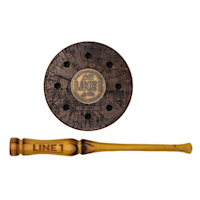
My bear-defense revolver has a black walnut grip. My favorite fishing net has a black walnut handle and hoop. This coming turkey season, I can already tell my go-to pot call will be this beautiful, black walnut number known as the Phelps Line 1.
This isn’t your average turkey call. While most are built from bulk lumber, Jason Phelps and Steven Rinella decided to make this one a bit different.
“If you look at the pot calls out there, nobody ever tells you where the wood comes from. There's no story behind it,” Jason told me.
Back in high school, Steve cut down some oaks with his father that, years later, became his writing desk and workbench. He pitched the idea of making a call with some history behind it to Jason, who was skeptical at first before getting really excited about it. So, last May, the two traveled to the Turkey Creek Farm outside Uniontown, Kansas, where Jason killed a gobbler the previous spring, this time on the hunt for something that doesn’t run away. After consulting with landowner Randy Milligan and veteran logger Joe Butler, they wandered the lush, springtime woods in search of the perfect tree—one without too many limbs, knots, and defects that they could potentially recover 1,000 pots from.
They finally found it: a tall, straight-trunked black walnut in a strip of timber separating corn and clover fields that fit their bill. Steve and Jason felled the valuable timber flush to the ground, also harvesting an Osage orange from across the field from which to make their strikers. They hauled their lumber to a mill in nearby Walnut, Kansas to cut planks, then Jason shipped it all to a kiln near his home in Washington State. Dried to an exact 7% moisture content over six weeks and cut into blocks, the pot calls began to take shape. Once lathed and lacquered, the finished wood looked like some rich chocolate dessert.
Continuing with their desire to build these calls entirely in the United States with all American materials, they then mounted the resonating pots with West Virginia slate soundboards, Illinois crystal, weathered medallions on the floor, and sequential, limited-edition numbering. You almost hate to scratch up the surface of that pretty call, but once you do, it purrs soft and seductive. Push a little harder and you’ll get bright, high-pitched yelps audible for a mile. It’s a caller’s call; palm-sized but loud, crisp but subtle, designed by some of the best in the call building and turkey killing game.
“It's a beautiful, good-for-the-rest-of-your-life kind of thing,” Steve told me. “Folks will love having something that they can refer back to a specific tree in a specific place, with a specific collection of people that sawed it, milled it, dried it, crafted it. These calls are gorgeous and they tell a cool story.”
Steve and Jason only got 1,400 of these calls out of that black walnut and they’re available for purchase now. You can learn more about this project and watch the video here. Steve and Jason also discuss the call on the first episode of the re-launched Cutting the Distance Podcast with Phelps as the new host. These won’t last long, so don’t miss out. You can get yours here.






